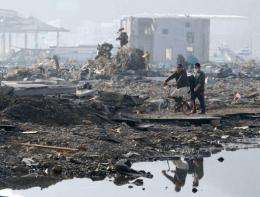Monsoons spinning the Earth's plates: study

(������ƵOrg.com) -- Scientists have for the first time shown a link between intensifying climate events and tectonic plate movement in findings that could provide a valuable insight into why huge tremors occur.
A new study from The Australian National University has for the first time confirmed that long-term climate change has the potential to spin the Earth’s tectonic plates.
Dr Giampiero Iaffaldano from the ANU Research School of Earth Sciences and colleagues in France and Germany have established a link between the motion of the Indian plate over the past 10 million years and a specific climate change event over the same period: the intensification of the Indian monsoon.
Dr Iaffaldano said that the monsoon, which increased rainfall in northeast Indian by four metres annually, sped up motion in the Indian plate by almost one centimetre per year.
“The 100km-thick outer shell of Earth, the lithosphere, is divided into pieces called tectonic plates. Plates move in different directions at speeds in the order of centimetres per year, comparable to the speed of fingernail growth in humans.
“The significance of this finding lies in recognising for the first time that long-term climate changes have the potential to act as a force and influence the motion of tectonic plates. It is known that certain geologic events caused by plate motions – for example the drift of continents, the closure of ocean basins and the building of large mountain belts – have the ability to influence climate patterns over a period of a million years.
“Now we know that the opposite holds as well: long-term climate change, or the natural changes in climate patterns over millions of years, can modify the motion of plates in a feedback mechanism.”
Dr Iaffaldano added that the finding could help unlock the causes of plate-motion events like large-scale earthquakes.
“When forces moving plates along their boundaries reach certain thresholds, earthquakes occur and energy is released. This happens cyclically, typically every several hundred years in the case of large earthquakes. However it appears that the seismic potential of plate boundaries, which is an indication of how prone these are to large earthquakes, depends, among other factors, also on how strong or weak these forces have been in the past. In other words, it depends also on the history of plates over millions of years.
“In order to understand the seismic potential of plate boundaries it is important to identify all the possible factors that caused plate motion to change in the past. In that respect we have discovered that climate change could in fact be one possible candidate, something we did not consider until now.
“This new knowledge shall be used to analyse the past behaviour of plates in the Earth’s crust. Ultimately we aim at understanding what caused plate motions to change and which regions are currently more prone to large earthquakes. To that end, we may also have to consider the history of climate over the past million years.”
More information: Monsoon speeds up Indian plate motion, Earth and Planetary Science Letters, Volume 304, Issues 3-4, 15 April 2011, Pages 503-510. doi:10.1016/j.epsl.2011.02.026
Provided by Australian National University
















